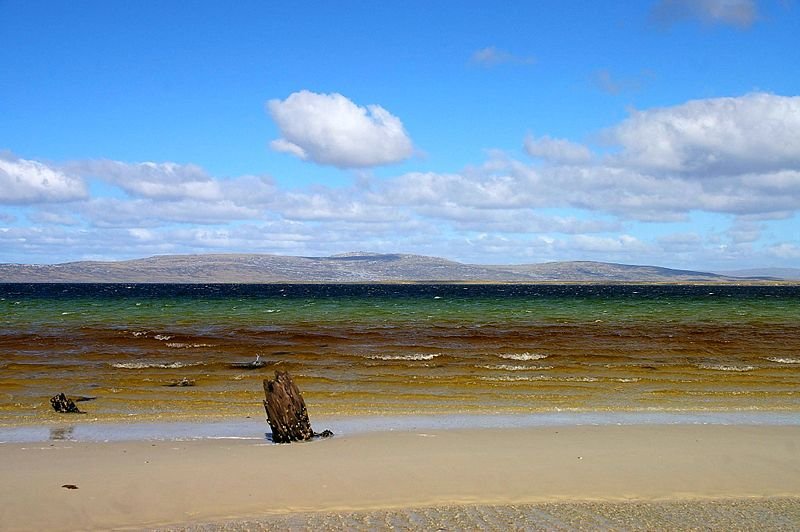 Berkeley Sound, Falklands
Berkeley Sound, FalklandsSource: https://commons.wikimedia.org/wiki/File:Berkeley-Sound.jpg
Author: Ben Tubby

Falkland Islands is an archipelago in the South Atlantic Ocean. It is located about 450 km (290 mi, 250 nautical miles) off the coast of Argentina. The island group, which comprises East Falkland, West Falkland, and over seven hundred small islets, cover a total area of 12,173 sq km (4,700 sq mi). It has a population of around three thousand people. The capital and main town in the Falkland Islands is Stanley.
The Falkland Islands is a British Overseas Territory with Queen Elizabeth II as the monarch represented by a governor. Local Falkland Islanders form the majority of the locals, over 60% of the population. There is also close to 30% of ethnic British on the islands.
The Falkland Islands are four hours behind Coordinated Universal Time (UTC-4) except during Daylight Saving Time in summer, when it is three hours behind (UTC-3). The official currency used here is the Falkland Islands pound. Traffic is driven on the left, as in Britain. The phone IDD code is +500. The electricity is 240V/50Hz using UK plug.
 King Penguins in the Falkland Islands
King Penguins in the Falkland IslandsSource: https://commons.wikimedia.org/wiki/File:Falkland_Islands_Penguins_26.jpg
Author: Ben Tubby

The Falkland Islands have a coastline totaling around 1288 km (800 mi). The main town, Stanley, is on East Falkland. The two main islands are separated by the Falkland Sound, which is approximately 20 km (12 mi) wide. The highest mountain is Mount Usborne, also on East Falkland, at 705 m (2,313 ft). East Falkland itself comprises two parts joined together by a narrow isthmus. The southern peninsula is known as Lafonia, a relatively flat area compared to elsewhere in the Falklands.
The Falkland Islands experiences a Maritime Subartic climate. December to February are the warmest months, when average temperatures reach 13°C (55°F). June to August are the coldest months, when the average temperatures drop to -1°C (30°F).
 The coast of Saunders Island, one of the islands within the Falkland Islands
The coast of Saunders Island, one of the islands within the Falkland IslandsSource: https://commons.wikimedia.org/wiki/File:Black-browed-albatross-Colony.jpg
Author: Ben Tubby

The economy of the Falkland Islands is traditionally dependent on fishing, with tourism being a new and growing industry. The islands have become a regular port of call for ocean liners and cruise ships. In 2005, it had an estimated GDP at purchasing power parity of $75 million. Its per capita GDP in 2002 stood at $25,000.
Despite evidence of early human habitation, the earliest Europeans to arrive in the Falklands found the islands to be uninhabited. First sighting of the Falklands have been claimed by the Portuguese, the Spanish and the British, although the most reliable sighting is attributed to Dutch explorer Sebald de Weert in 1600.
 Stone run on Mount Kent, Falklands
Stone run on Mount Kent, FalklandsSource: https://commons.wikimedia.org/wiki/File:Stone-run.JPG
Author: Apcbg

Captain John Strong was credited with giving the islands their name. In 1690 his ship was blown off course, and he found himself sailing between the two islands. He called the passage the Falkland Channel, after Anthony Cary, the 5th Viscount Falkland. The passage is today known as Falkland Sound.
The French established the earliest settlement in the Falklands. French navigator Louis Antoine de Bougainville started the settlement in present-day Port Louis, in East Falkland, in 1764. This was followed a year later by Captain John Byron claiming Saunders Islands on West Falkland for the British. The Spanish later acquired the French colony and forced the British to withdraw from the Falklands. Spain maintained its hold on the Falklands until 1811.
 Stanley, the main settlement on the Falkland Islands
Stanley, the main settlement on the Falkland IslandsSource: https://commons.wikimedia.org/wiki/File:View_of_Stanley,_Falkland_Islands.jpg
Author: Alex Petrenko

In November 1832, Argentina attempted to establish a penal settlement in the Falkland without much success. Two months later, the British returned to the Falklands and asked Argentina to leave the islands.
Argentina renewed its claim to the Falkland Islands in the 1960's. Several negotiations between the British and Argentine foreign missions failed to reach an agreement, largely because the people living on the Falkland Islands preferred it to remain British territory.
On 2 April 1982, Argentina attempted to take the Falkland Islands by force. The Argentine military junta sent its troops to the Falklands, resulting in the Falkland War. On 14 June, 1982, after a short but fierce confrontation, Argentina was forced to surrender. The conflict claimed the lives of 255 British and 649 Argentine soldiers, forcing Britain to increase its military presence on the islands. Both the United Kingdom and Argentina continue to press their respective claims over the islands since then.
 Seabirds nest on the cliff at Saunders Island
Seabirds nest on the cliff at Saunders IslandSource: https://commons.wikimedia.org/wiki/File:Turkey_Vulture_and_Black-browed_Albatrosses_(5585843805).jpg
Author: Liam Quinn

Planning your visit to Falkland Islands
Visitors from Britain, North America, Chile, most Commonwealth countries and the European Union do not need a visa to enter the Falklands. If you are from a country not mentioned above, please check with the embassy.The main airport serving the Falklands is Mount Pleasant Airport (MPN), a British Royal Air Force base on East Falklands. Visitors from Britain fly from the RAF Brize Norton base in Oxfordshire. There are also weekly flights from Santiago de Chile.
Major Cities in Falkland Islands
- Stanley - capital
- Goose Green
- Port Howard
Islands in Falkland Islands
- East Island
- West Island
- Carcass Island
- New Island
- Pebble Island
- Saunders Island
- Sea Lion Island
 Latest updates on Penang Travel Tips
Latest updates on Penang Travel Tips

Copyright © 2003-2025 Timothy Tye. All Rights Reserved.

 Go Back
Go Back